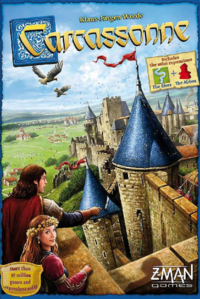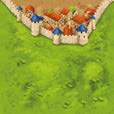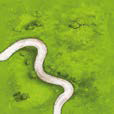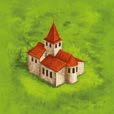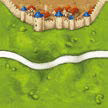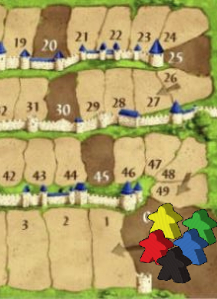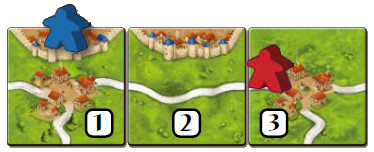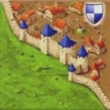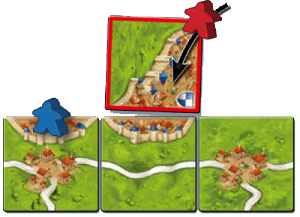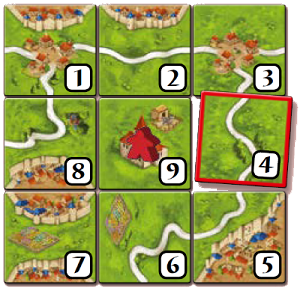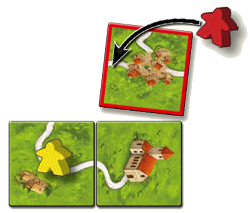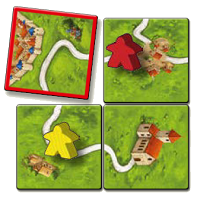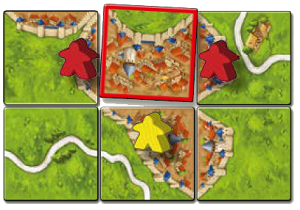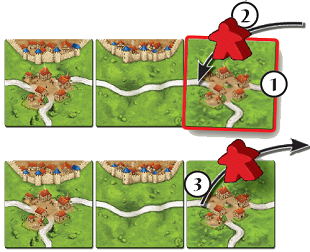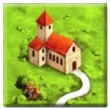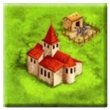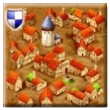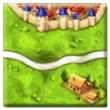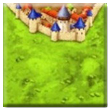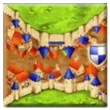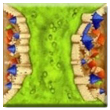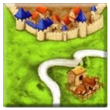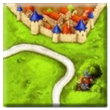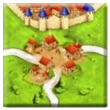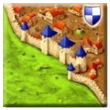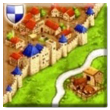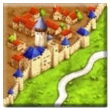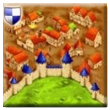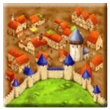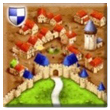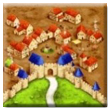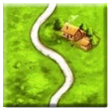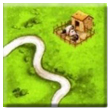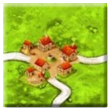Difference between revisions of "Base game/de"
(Created page with "'''Jede Karte einer fertiggestellten Stadt ist 2 Punkte wert. Darüber hinaus ist jedes Wappen 2 weitere Punkte wert.'''<ref>{{IconWorld}} Beachte, dass ein Wappen nur den Sta...") |
|||
| Line 124: | Line 124: | ||
3=Setzen wir unser Beispiel fort und gehen davon aus, dass einige Runden gespielt wurden. Du ziehst nun diese Karte, legst sie an, um deine Stadt fortzusetzen. Da die von Ihnen platzierte Karte die Stadt fertigstellt, muss sie nun gewertet werden. Eine Stadt ist fertig, wenn sie von Mauern umgeben ist und es keine Lücken innerhalb der Stadt gibt. Da du in der fertiggestellten Stadt einen Gefolgsmann hast, bist du der Spieler, der sie bewertet. | 3=Setzen wir unser Beispiel fort und gehen davon aus, dass einige Runden gespielt wurden. Du ziehst nun diese Karte, legst sie an, um deine Stadt fortzusetzen. Da die von Ihnen platzierte Karte die Stadt fertigstellt, muss sie nun gewertet werden. Eine Stadt ist fertig, wenn sie von Mauern umgeben ist und es keine Lücken innerhalb der Stadt gibt. Da du in der fertiggestellten Stadt einen Gefolgsmann hast, bist du der Spieler, der sie bewertet. | ||
'''Jede Karte einer fertiggestellten Stadt ist 2 Punkte wert. Darüber hinaus ist jedes Wappen 2 weitere Punkte wert.'''<ref>{{IconWorld}} Beachte, dass ein Wappen nur den Stadtteil betrifft, in dem es sich befindet, nicht auf weitere Stadtteile auf der Karte.</ref> Für diese Stadt erhalten Sie 8 Punkte! Wie üblich, kehrt der Gefolgsmann in den Vorrat zurück. | '''Jede Karte einer fertiggestellten Stadt ist 2 Punkte wert. Darüber hinaus ist jedes Wappen 2 weitere Punkte wert.'''<ref>{{IconWorld}} Beachte, dass ein Wappen nur den Stadtteil betrifft, in dem es sich befindet, nicht auf weitere Stadtteile auf der Karte.</ref> Für diese Stadt erhalten Sie 8 Punkte! Wie üblich, kehrt der Gefolgsmann in den Vorrat zurück. | ||
[[File:New_rules_city_example_b.png|none|frame|Abgeschlossene Stadt-Wertung. | [[File:New_rules_city_example_b.png|none|frame|Abgeschlossene Stadt-Wertung.]] | ||
}} | }} | ||
=== Klöster === | === Klöster === | ||
Revision as of 22:23, 3 February 2019
Allgemeine Informationen und Kommentare
Ursprünglich von Hans im Glück im Template:Year de herausgegeben.
Carcassonne, die weltberühmte französische Stadt, ist bekannt für ihre imposanten Festungen, die in der Antike und im Mittelalter errichtet wurden. Diese Festung, umgeben von prächtigen Mauern, gilt noch heute als eine der einzigartigsten französischen Städte. In diesem Spiel müssen die Spieler das Gebiet um Carcassonne entwickeln. Sie stellen ihre Anhänger auf Straßen und in Städte, Klöster und Felder. Nur diejenigen, die die sinnvollsten Platzierungen vornehmen, erhalten die für den Sieg erforderlichen Punkte.
Information zu der Bauernregel
Für die meisten Carcassonne-Spieler gelten die Bauern als Teil des Basisspiels. Sie werden auch bei jedem offiziellen Turnier verwendet, da sie nicht als Erweiterung angesehen werden. In der neuen Ausgabe von Carcassonne wurden die Bauern als Erweiterung abgetrennt, um neuen Spielern den Zugang zum Spiel zu erleichtern. WikiCarpedia verfolgt diesen optimierten Ansatz. Im Interesse anderer Erweiterungen und des Restes der WikiCarpedia werden die Bauern als Teil des Basisspiels betrachtet. Sie finden die Regeln Die Bauern hier.
Komponenten und Aufbau
Der folgende Teil erklärt das anfängliche Setup und stellt Komponenten des Spiels vor.
Die 72 Karten zeigen Straßen, Städte und Klöster auf einer Wiese.
Die Rückseiten der Karten sind gleich, aber die STARTKARTE hat eine dunkler gefärbte Rückseite, sodass man sie leicht erkennen kann. Andere grafische Elemente wie Häuser, Leute oder Tiere haben keinen Einfluss auf das Spiel.[1]
Legen Sie die Startkarte (die mit einer dunklen Rückseite) in die Mitte des Tischs.[2]. Mischen Sie die übrigen Karten und setzen Sie diese als verschiedene Stapel mit der Bildseite nach unten ab.[3] die leicht für alle Spieler zugänglich sind.
Dann kommt die Zählleiste, die Sie zur Seite ihrer Spielfläche stellen (Tisch, Boden, etc.).
Schließlich haben wir die Meeple. Sie werden in der Box 40 normale Meeple vorfinden, darunter 8[4]Meeple in jeder dieser Farben: gelb, rot, grün, blau, schwarz[5]Zusätzlich gibt es noch 5 Äbte.<![]() Die Nutzung der Äbte wird auf der Minierweiterungsseite der Abt, welche einen in jeder Farbe enthält, beschrieben.
Die Nutzung der Äbte wird auf der Minierweiterungsseite der Abt, welche einen in jeder Farbe enthält, beschrieben.
Starten Sie indem sie jedem Spieler 7 Meeple in der Farbe ihrer Wahl geben. Diese Meeple bilden den persönlichen Vorrat jedes Spielers.Platzieren sie den achten Meeple jedes Spielers auf den 0-Platz auf der Punktetafel. Diese werden benutzt um durchwegs des Spiels die Punkte jedes Spielers zu verfolgen. Wenn Sie nicht mit der Abt spielen, tun sie diese einzigartigen Meeple zurück in die Box.
Überblick und Ziel der Spiels
In Carcassonne wechseln sich die Spieler ab, Karten anzulegen und die Landschaft von Straßen, Städten, Klöstern und Wiesen zu erweitern, eine Karte nach der anderen. Die Spieler können ihre Gefolgsmännern auf Straßen, Städte, Klöster und Wiesen setzen, wo sie zu Wegelagerern, Rittern und Mönchen werden. Während des gesamten Spiels werden Punkte gesammelt, und der Spieler mit der höchsten Punktzahl am Ende ist der Gewinner!
Spielablauf
Das Spiel von Carcassonne wird im Uhrzeigersinn gespielt. Beginnend mit dem jüngsten Spieler[6], der aktuelle Spieler führt die folgenden Aktionen in der unten aufgeführten Reihenfolge durch, danach ist der nächste Spieler an der Reihe, und so weiter und so fort. Zuerst geben wir dir eine kurze Beschreibung der Aktionen, die du während eines deiner Züge ausführen musst. Diese Aktionen werden detailliert beschrieben, wenn wir die Straßen, die Städte und schließlich die Klöster vorstellen. Was sind also diese Aktionen?
- Legen einer Karte: Der Spieler muss genau eine Karte von einem Stapel ziehen und legt diese, mit der Oberseite nach oben, an.[7][8][9]
- Der Spieler kann einen Gefolgsmann aus seinem Vorrat auf die Karten setzen, die er gerade angelegt hat.
- Wertung: Der Spieler muss alles werten, was durch das Anlegen der Karte fertiggestellt.
Strassen
Legen der Karte
Sie ziehen die abgebildete Fliese mit drei Straßenabschnitten, die von einem Dorf aus beginnen. Sie müssen es so anlegen, dass es die bestehende Landschaft (die bereits vorhandenen Kacheln) fortsetzt.[10]. In dem seltenen Fall, dass eine Karte nicht irgendwo angelegt werden kann und alle Spieler zustimmen, wird diese aus dem Spiel entfernt und der Spieler zieht einen anderen. [11]
Setzen eines Gefolgsmanns als Wegelagerer
Nachdem du die Karte angelegt hast, kannst du einen Gefolgsmann als Wegelagerer auf einen der Straßenabschnitte dieser Karte setzen, aber nur, wenn die Straße nicht von einem anderen Wegelagerer besetzt ist.
In unserem Beispiel, da die Straße noch nicht fertig ist, erfolgt keine Wertung (siehe Aktion 3) und das Spiel geht zum nächsten Spieler über.
Der nächste Spieler zieht eine Karte, die er anlegt um die Landschaft fortzusetzen. Er darf keinen Gefolgsmann auf die Straße nach rechts setzen, da bereits ein Wegelagerer auf dieser Straße anwesend ist. Stattdessen entscheidet er sich dafür, seinen Gefolgsmann als Ritter in den Stadtteil dieser Karte zu setzen.
Wertung einer Strasse
Wenn beide Enden einer Straße geschlossen sind, ist diese Straße abgeschlossen und wird gewertet. Das Ende einer Straße ist geschlossen, wenn sie auf ein Dorf trifft [12], eine Stadt, ein Kloster, oder eine andere Straße trifft.[13]
Auch wenn es dein Gegner ist, der die Karte gelegt hat, ist damit deine Straße komplett. Wie viele Punkte erhältst du? Wenn Sie eine Straße bewerten, bringt jede Karte dieser Straße 1 Punkt. Hier, da du eine Straße aus 3 Karten gewertet wird, bekommst du 3 Punkte.
Es ist jetzt an der Zeit, Ihre Punktzahl zu notieren. Du behältst den Überblick über deine Punktzahl mit dem Gefolgsmann, den du auf der Zählleiste platziert hast, bevor du das Spiel beginnst. In Fortsetzung unseres Beispiels bewegen Sie ihn um 3 Felder nach vorne, um zu zeigen, dass Sie 3 Punkte erzielt haben. Hinweis: Wenn deine Punktzahl 50 Punkte überschreitet, lege deinen Gefolgsmann hin, um deine 50+ Punkte anzuzeigen. Nach jeder Wertung kehren die Gefolgsmänner aus der Wertung in Deinen Vorrat zurück.
Wir haben bereits die wichtigsten Teile des Spiels betrachtet. Nun wenden wir uns den Städten und Klöstern zu:
Städte
Legen einer Karte
Setzen eines Gefolgsmanns als Ritter
Wertung einer Stadt
Setzen wir unser Beispiel fort und gehen davon aus, dass einige Runden gespielt wurden. Du ziehst nun diese Karte, legst sie an, um deine Stadt fortzusetzen. Da die von Ihnen platzierte Karte die Stadt fertigstellt, muss sie nun gewertet werden. Eine Stadt ist fertig, wenn sie von Mauern umgeben ist und es keine Lücken innerhalb der Stadt gibt. Da du in der fertiggestellten Stadt einen Gefolgsmann hast, bist du der Spieler, der sie bewertet.
Jede Karte einer fertiggestellten Stadt ist 2 Punkte wert. Darüber hinaus ist jedes Wappen 2 weitere Punkte wert.[14] Für diese Stadt erhalten Sie 8 Punkte! Wie üblich, kehrt der Gefolgsmann in den Vorrat zurück.
Klöster
Placing a tile
Placing a meeple as a monk
Scoring a monastery
A monastery is completed when it is surrounded by tiles. During scoring, the monastery is worth 1 point per tile that completes it (including the monastery itself).
By placing this tile, you complete your monastery. It earns you 9 points and allows you to take your meeple back.
We have already seen most of the rules for Carcassonne. There are only a few points left to see, but first, here is a summary of what we’ve seen so far:
Zusammenfassung
Placing a tile
- You must place your drawn tile in such a way that it continues the landscape and the illustration.
- In some very rare cases, it may be impossible to place the tile. In those cases, simply return the tile to the box and draw a new one.
Placing a meeple
- You may place a meeple on the tile you’ve just placed.
- You may not place a meeple in a feature where there already is at least one other meeple, including one of yours.
Scoring a feature
- A road is completed when both ends lead to a village, a city, a monastery, or the road forms a loop. Each tile in a completed road is worth 1 point.
- A city is completed when it is surrounded by walls and there are no holes inside the city. Each tile in the completed city is worth 2 points. Each coat of arms in the completed city is worth an extra 2 points.
- A monastery is completed when it is surrounded by 8 tiles. Each of the monastery’s tiles (the 8 surrounding tiles and the one with the monastery itself) is worth 1 point.
- Scoring always occurs at the end of a player’s turn. At that moment, each player with a meeple in a scored feature earns points.[15]
- After each scoring, return to your supply the scored meeples.
- If there are multiple meeples in a single scored feature, the player with the most meeples is awarded full points and all other players receive nothing. When more than one player have the most meeples in a scored feature, the tied players all score full points.
Game end and final scoring
The game ends immediately after the turn of the player who placed the last tile. Then, players proceed to a final scoring, after which the winner will be known.
Once the game is over, all meeples still in play are scored:
- Each incomplete road is worth 1 point per tile, just like during the game.
- Each incomplete city is worth 1 point per tile and 1 point per coat of arms, which is only half the points.
- Each incomplete monastery is worth 1 point plus 1 point per adjacent tile, just like during the game.
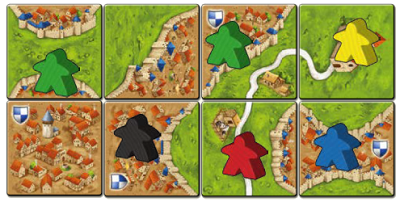
Final scoring - monastery: Yellow scores 4 points for this incomplete monastery (3 points for the adjacent tiles and 1 point for the monastery itself).
Final scoring - city: Blue scores 3 points for this incomplete city (2 tiles and 1 coat of arms).
Final scoring - road: Red scores 3 points for this incomplete roads (3 tiles).
Once the final score is known, the winner is the player with the most points.[16]
Sonderfälle
Viele Gefolgsmänner auf der gleichen Strasse
Viele Gefolgsmänner in der gleichen Stadt
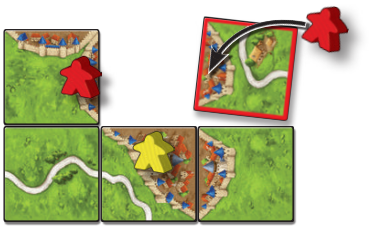
Use a Meeple, Score a Feature, and Get the Meeple Back
You can place a meeple in a feature you just completed, immediately score it, and then return the meeple to your supply.
To do so, follow these steps:[17]
__ 1. Place a tile, completing a feature (such as a road, city, or monastery).
__ 2. Place a meeple as a highwayman, knight, or monk on the feature you just completed.
__ 3. Score the completed road, city, or monastery and return the meeple to your supply.[18]
Haus-Regeln
- The players decide who starts the game by any method they choose—such as by rolling three followers. The first player to ‘roll’ a standing follower decides who plays first. (Thanks to Joff.)
- To determine the first player; each player draws a tile from the bag, the player that drew the tile with the most roads (0 to 4) plays first, if there is a tie for most roads, a draw-off takes place. This is repeated until someone wins. (Thanks to michael.)
- Take your next tile at the end of your turn, to give you time to think about placement and avoid analysis paralysis.
- Play with a three-tile hand. The abbey counts as part of your hand. Play your turn. including the builder, and then draw back up to three tiles. These tiles could be visible to all or hidden to the other players (Thanks to DavidP and youth.)
- When playing with a bag for the tiles, the original starting tile may be put into the bag, and unplayable tiles can be put back into the bag rather than set to one side. (Thanks to dwhitworth.)
- Trees (bushes) on roads do not end the road—only houses do (when the road forks). This makes road building a lot more dynamic. (Thanks to Tobias.)
- When a tile is the only tile which can currently complete a structure, other players can offer to ‘buy’ it by offering points, trades counter, abbey, and so on. (Thanks to Deatheux.)
- If you place a tile that fills a hole in the playing field by touching something on all four adjacent sides, you get another turn. This helps motivate people to finish the board even if they do not get an advantage from the placement. (Does not apply to the abbey tile). (Thanks to viberunner.)
- Incomplete features at the end of the game do not score points at the end of the game. (Thanks to metoth.)
- The edge of the table limits the playing area. Thus, a player may not place a tile past the edge of the table or move the playing area to place a tile that would have been past the edge of the table. (Thanks to metoth for prompting this one, and to SkullOne for pointing out that this is an official rule from Hunters and Gatherers.)
- Table borders COMPLETE features as an abbey would. (Thanks to PreGy.)
- Use colored dice instead of meeples on the scoring track. Start out with the 6 showing on top. When the marker completes one lap, turn it to the number 1 to indicate it has completed one lap. This shows at a glance which player is on what lap and who's ahead. On the 100 space track it’s even easier to determine someone’s score at a glance. (Thanks to Carcking.)
Use of a Table
A number of questions have been asked about rules related to the play area itself, including what happens when the edge of the area is reached, or if a table has to be used for play. The following clarifications are from Georg Wild from HiG (5/2013):
- The edge of the table is the limit for the game if, as stated in the rules, a table is used.
- The rules state that the starting tile is placed in the middle of the table. If all of the tiles are shifted to allow more room, the starting tile would no longer be in the middle. So in principle, total shifting of the tiles is not allowed. Additionally, with a manual shift of all of the tiles, the tiles and figures on the field can slip, which could lead to incorrect positioning of tiles or figures.
- Addition of a second table is possible if one of an appropriate height is added to the first table. If a table is extended (as with an additional panel), make sure that the tiles and figures on the playing field do not slip.
- Playing on the floor: The rules technically do not allow this, because the rules state that the first tile is placed in the middle of the table. Playing on the floor is not forbidden, however, if use of a table is not feasible. If the floor is used, tiles must be placed so all tiles are visible to all players. Tiles cannot be placed under the sofa, cabinet/shelf, etc.
- It is important generally, that all the players in the round agree how to play:
- Table - Standard
- Table - with "total shifting" of tiles
- Table - with extension
- Floor
- Continue to play fairly and not intentionally unfair to other players.
Tile reference
Anzahl Karten: 72
One of the tiles marked with "(S)" -tile number four- is the starting tile (with a dark back).
Many of the tiles have a small illustration on them. The letters in brackets show which illustration is on each tile:
Referenzen
Für Lizenzen und Erklärungen besuche Icons page.
- ↑
 Sie haben keinen Einfluss auf die Grundregeln. Diese werden oder werden wahrscheinlich in Erweiterungen benutzt werden. Z.B. Die Märkte zu Leipig
Sie haben keinen Einfluss auf die Grundregeln. Diese werden oder werden wahrscheinlich in Erweiterungen benutzt werden. Z.B. Die Märkte zu Leipig
- ↑
 Siehe auch Notizen zu Benutzung eines Tischs
Siehe auch Notizen zu Benutzung eines Tischs
- ↑
 Karten können auch in einen Sack gepackt werden und zufällig gezogen werden.
Karten können auch in einen Sack gepackt werden und zufällig gezogen werden.
- ↑
 Frage: Zu wenig Gefolgsleute - spielen wir das falsche Spiel oder gibt es wirklich zu wenig?Antwort:In unserem Blickpunkt sind es nicht zu wenig. Eine gewisse Knappheit an Gefolgsleuten ist absichtlich. Ein wichtiges Element des Spiels ist es präzise zu lernen sparsam mit seinen Gefolgsleuten zu sein.
Frage: Zu wenig Gefolgsleute - spielen wir das falsche Spiel oder gibt es wirklich zu wenig?Antwort:In unserem Blickpunkt sind es nicht zu wenig. Eine gewisse Knappheit an Gefolgsleuten ist absichtlich. Ein wichtiges Element des Spiels ist es präzise zu lernen sparsam mit seinen Gefolgsleuten zu sein.
- ↑ Soweit wie die Big Box 6 betroffen ist, ist das sechste Set (pink) Gefolgsleute Teil des Grundspiels, nicht von Wirthshäuser & Kathedrahlen .
- ↑
 . Es ist üblich, den Startspieler nach dem Zufallsprinzip zu wählen. Mehr dazu im Abschnitt Hausregeln.
. Es ist üblich, den Startspieler nach dem Zufallsprinzip zu wählen. Mehr dazu im Abschnitt Hausregeln.
- ↑
 Wir haben Schwierigkeiten zu entscheiden, wann eine angelegte Karte eine neue Stadt ist oder zu einer bereits im Bau befindlichen Stadt gehört. Antwort: 'Ecke an Ecke' ist keine Verbindung! Stadtteile können nur an den Kanten verbunden werden. Im gezeigten Beispiel gibt es zur Zeit zwei Städte.
Wir haben Schwierigkeiten zu entscheiden, wann eine angelegte Karte eine neue Stadt ist oder zu einer bereits im Bau befindlichen Stadt gehört. Antwort: 'Ecke an Ecke' ist keine Verbindung! Stadtteile können nur an den Kanten verbunden werden. Im gezeigten Beispiel gibt es zur Zeit zwei Städte.
- ↑
 Die Klöster können direkt nebeneinander oder Ecke an Ecke gelegt werden. Es ist nicht notwendig, dass acht weitere (nicht Kloster-) Karten an ein Kloster angrenzen. Im Gegensatz zu Straßen, Städten und Wiesen ist es nicht möglich, sich mit einem Kloster zu verbinden.
Die Klöster können direkt nebeneinander oder Ecke an Ecke gelegt werden. Es ist nicht notwendig, dass acht weitere (nicht Kloster-) Karten an ein Kloster angrenzen. Im Gegensatz zu Straßen, Städten und Wiesen ist es nicht möglich, sich mit einem Kloster zu verbinden.
- ↑
 Ein neu angelegte Karte muss an allen Kanten in das angrenzende Gelände passen. Während dem Legen reicht es nicht aus, nur nach einer Seite zu suchen, die passt.
Ein neu angelegte Karte muss an allen Kanten in das angrenzende Gelände passen. Während dem Legen reicht es nicht aus, nur nach einer Seite zu suchen, die passt.
- ↑
 Frage: Darf man bei Klosterkarten ein Gefolgsmann außerhalb des Klosters setzen? Antwort: Ja! Für die Umgebung eines Klosters gelten die gleichen Regeln wie für jede andere Karte. Du kannst auch einen Bauern neben das Kloster setzen. In diesem Fall bleibt das Kloster für den Rest des Spiels unbesetzt.
Frage: Darf man bei Klosterkarten ein Gefolgsmann außerhalb des Klosters setzen? Antwort: Ja! Für die Umgebung eines Klosters gelten die gleichen Regeln wie für jede andere Karte. Du kannst auch einen Bauern neben das Kloster setzen. In diesem Fall bleibt das Kloster für den Rest des Spiels unbesetzt.
- ↑
 Wenn Sie die Karten aus einem Beutel ziehen, kann die Fliese, die nicht angelegt werden kann, zur späteren Verwendung in den Beutel zurückgegeben werden.
Wenn Sie die Karten aus einem Beutel ziehen, kann die Fliese, die nicht angelegt werden kann, zur späteren Verwendung in den Beutel zurückgegeben werden.
- ↑
 . Ein Dorf ist ein kleine Ansammlung von roten Gebäuden, die die Kreuzung umgeben.
. Ein Dorf ist ein kleine Ansammlung von roten Gebäuden, die die Kreuzung umgeben.
- ↑
 Frage: Darf eine Straße im nichts enden? Antwort: Nein, wie alle anderen Karten muss ein Straßenabschnitt an allen Kanten mit einem anderen Straßenabschnitt fortgesetzt werden.
Frage: Darf eine Straße im nichts enden? Antwort: Nein, wie alle anderen Karten muss ein Straßenabschnitt an allen Kanten mit einem anderen Straßenabschnitt fortgesetzt werden.
- ↑
 Beachte, dass ein Wappen nur den Stadtteil betrifft, in dem es sich befindet, nicht auf weitere Stadtteile auf der Karte.
Beachte, dass ein Wappen nur den Stadtteil betrifft, in dem es sich befindet, nicht auf weitere Stadtteile auf der Karte.
- ↑
 When two followers of one color are occupying a road, city, or farm, you do not score double in these cases. The number of followers (or in Inns and Cathedrals the size of the followers) has no effect on the points that a player earns from a road, city, cloister, or farm. Two knights do not double the points. The number of followers is only important in establishing who has the majority.
When two followers of one color are occupying a road, city, or farm, you do not score double in these cases. The number of followers (or in Inns and Cathedrals the size of the followers) has no effect on the points that a player earns from a road, city, cloister, or farm. Two knights do not double the points. The number of followers is only important in establishing who has the majority.
- ↑
 Rules do not include tiebreakers. That is rules explaining situation when few players share the same score.
Rules do not include tiebreakers. That is rules explaining situation when few players share the same score.
- ↑
 Note in the box that features are considered to be complete as soon as the tile is placed, although follower placement and scoring only occur afterwards. This is important when playing with The Flier.
Note in the box that features are considered to be complete as soon as the tile is placed, although follower placement and scoring only occur afterwards. This is important when playing with The Flier.
- ↑
 Question: There is a situation that puzzles us. If a player draws a tile with two city segments and completes a small city, earning 4 points, can he or she then deploy a follower to a new city segment in the same turn? Answer: A player may only deploy one follower per turn, and that follower may be deployed only once, and it must be before any scoring. If the player already occupies the small, now-completed city, he or she may deploy a second follower to the other city segment immediately after placing the tile. The small city will then be scored and the follower involved returned to the player. If the player does not yet occupy this city, he or she can decide which of the two city segments to deploy a follower to. If the follower is deployed to the small city, it will be returned immediately and the player will earn four points, but the follower cannot be redeployed.
Question: There is a situation that puzzles us. If a player draws a tile with two city segments and completes a small city, earning 4 points, can he or she then deploy a follower to a new city segment in the same turn? Answer: A player may only deploy one follower per turn, and that follower may be deployed only once, and it must be before any scoring. If the player already occupies the small, now-completed city, he or she may deploy a second follower to the other city segment immediately after placing the tile. The small city will then be scored and the follower involved returned to the player. If the player does not yet occupy this city, he or she can decide which of the two city segments to deploy a follower to. If the follower is deployed to the small city, it will be returned immediately and the player will earn four points, but the follower cannot be redeployed.
